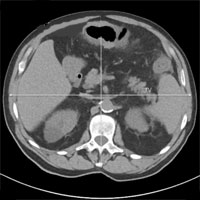Tag: pain

Determinants of Health-Related Quality of Life After ICU
Preexisting comorbidity counts, but not severity of ICU illness, are strongly associated with health-related quality of life and physical symptoms in the year following critical illness. We prospectively collected data... read more

Abdominal Compartment Syndrome
Abdominal compartment syndrome (ACS) is defined by sustained intra-abdominal pressure (IAP) > 20 mm Hg with associated organ injury. The condition was first described in 1863, but not significantly discussed until the 1990s.... read more

Subanesthetic Ketamine Infusions for the Management of Pediatric Pain in Non‐critical Care Settings
Ketamine can effectively be used as part of a multimodal analgesic regimen in pediatric patients in non‐critical care settings. Our five‐year experience using low‐dose ketamine infusions highlights an acceptable side... read more

Effect of Single-Dose Dexmedetomidine on Intraoperative Hemodynamics and Postoperative Recovery during Pediatric Adenotonsillectomy
Premedication of dexmedetomidine at the dose of 1 μg/kg in children undergoing adenotonsillectomy resulted in favorable effect on intraoperative hemodynamics, significant decrease in postoperative EA without causing any... read more

Pain in the PICU: How and What Are We Doing?
Pain management in critically ill children is complex. Epidemiological research is needed to identify how often patients in pediatric intensive care units (PICU) experience pain and the practices being used to lessen pain. Critically... read more

Evaluation of a Safer Opioid Prescribing Protocol (SOPP) for Patients Being Discharged From a Trauma Service
The aims of this study were to evaluate the effects on opioid medication prescribing, patient opioid safety education, and prescribing of naloxone following implementation of a Safer Opioid Prescribing Protocol (SOPP) as... read more

Evaluation of Medetomidine-ketamine and Atipamezole for Reversible Anesthesia of Free-ranging Gray Wolves
Twenty-eight anesthetic events were carried out on 24 free-ranging Scandinavian gray wolves (Canis lupus) by darting from a helicopter with 5 mg medetomidine and 250 mg ketamine during winter in 2002 and 2003. Mean±SD doses... read more

Ketamine In Acute and Chronic Pain Management
The view of chronic pain as a symptom of a disease, rather than a disease state itself, has contributed to neglect in treating this condition. Although it is generally acknowledged that patients with chronic pain use significantly... read more

Improved Guideline Adherence and Reduced Brain Dysfunction After a Multicenter Multifaceted Implementation of ICU Delirium Guidelines in 3,930 Patients
This large pre-post implementation study of delirium-oriented measures based on the 2013 Pain, Agitation, and Delirium guidelines showed improved health professionals’ adherence to delirium guidelines and reduced brain... read more

Improving Hospital Survival and Reducing Brain Dysfunction at Seven California Community Hospitals
The evidence-based ABCDEF bundle was successfully implemented in seven community hospital ICUs using an interprofessional team model to operationalize the Pain, Agitation, and Delirium guidelines. Higher bundle compliance... read more

Comparison of Two Lidocaine Administration Techniques on Perceived Pain From Bedside Procedures
Bedside procedures are exceedingly common. Data regarding the severity of procedural pain and strategies to mitigate it are important for the informed consent process and patient satisfaction. Overall, pain reported from... read more

Evaluation of Stressors in ICUs
The environmental and psychological factors affecting intensive care unit patients varied according to age, sex, and educational and surgical status. These factors had adverse effects on the patients. The elimination or modification... read more

Clinical Practice Guidelines for the Prevention and Management of Pain, Agitation/Sedation, Delirium, Immobility, and Sleep Disruption in Adult Patients in the ICU
Under the auspices of the Society of Critical Care Medicine, this executive summary aims to provide the most clinically meaningful and novel aspects, by section, of the PADIS guidelines that clinicians, stakeholders, and... read more

Music Helps Prevent Delirium in Elderly Critical Care Patients
A randomized controlled trial demonstrates that music intervention to prevent delirium among older patients is one of few strategies that provide support in a critical care setting. This study builds on non-pharmacologic... read more




